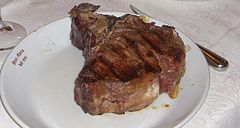|
À la carte

In restaurants, à la carte (/ɑːləˈkɑːrt/; French: [a la kaʁt]; lit. 'at the card')[1] is the practice of ordering individual dishes from a menu in a restaurant, as opposed to table d'hôte, where a set menu is offered.[2] It is an early 19th century loan from French meaning "according to the menu".[3][4] The individual dishes to be ordered may include side dishes, or the side dishes may be offered separately, in which case, they are also considered à la carte. HistoryThe earliest examples of à la carte are from 1816 for the adjectival use ("à la carte meal", for example) and from 1821 for the adverbial use ("meals were served à la carte").[3] These pre-date the use of the word menu, which came into English in the 1830s.[5][6][3] See also
References
Bibliography
External linksLook up à la carte in Wiktionary, the free dictionary.
|
